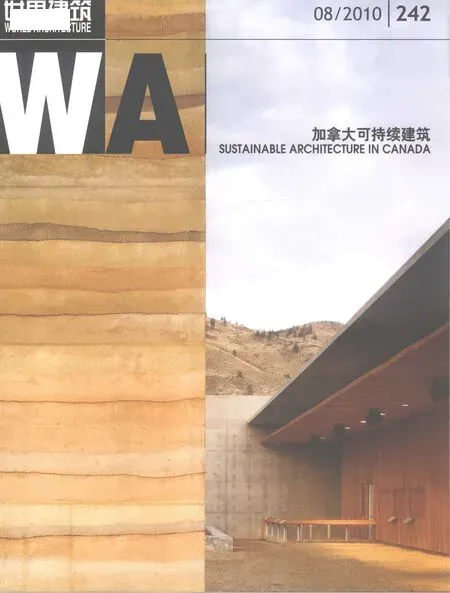篇首语
可持续建筑评估体系LEED的出现,对北美可持续建筑的发展产生了快速的推动作用。它标志着可持续建筑已经广泛地从理论研究落实到了建筑实践中。LEED评估体系不仅为建造可持续建筑提供了一些关键措施和方法,而且成功地在全球范围内促进了整个建筑市场的转变。在加拿大,目前可持续建筑评估采用的标准是加拿大LEEDNC 1.0,适用于新建和重大改建工程,它是在美国绿色建筑协会LEED-NC 2.1的基础上,依据加拿大的气候特点进行了改编的标准。
在本期加拿大可持续建筑专辑中,我们不仅介绍了一些最新的高投入、高性能表现的可持续建筑,如温哥华会议中心和温哥华冬奥会运动员村,还介绍了一些所谓“低技术”的作品, 运用传统地方性手法、地方材料以及被动式太阳能和地源热泵等手段。尼科米普沙漠文化中心和克劳福德湾学校就是这样的作品。 此外,随着节能技术成本的不断降低, 加拿大可持续建筑的发展也呈现出了一些新的、追求更高标准的动向,大学城托幼设施和不列颠哥伦比亚大学的可持续发展交互研究中心,都是力求做到零能耗和完全不依赖于市政管网的设计实例。这两个项目也是以“生态建筑挑战”这一零能耗标准为设计目标的项目。
“所有评估体系的目的都是要促使市场的转变”。中国在2006年颁布了自己的绿色建筑评估体系——绿色建筑评价标识认证,三星标准。如何促使整个建筑行业和市场的转变,是中国可持续建筑发展要解决的关键问题。缺少具有建筑整合设计能力的专业人才,缺少可信赖的可持续建材市场以及过高的建设成本投入,这些是中国发展可持续建筑面临的最大挑战。通过学习加拿大可持续建筑发展的有益经验,并试图找到自己发展的解决方案是我们出版这期加拿大可持续建筑专辑的目的。□(孙捷)
Since the advent of LEED Green Building Rating System, the development of sustainable building has gained a rapid progress in North America. It indicates that sustainable buildings have widely developed from theory to industry practice. The LEED rating System has not only directed the industry some key measures and methods of sustainable building design, but also transformed the market successfully and globally. In Canada, the current rating system is LEED Canada-NC 1.0 Green Building Rating System for New Construction and Major Renovations and is adapted from the USGBC LEED-NC 2.1, but tailored specifically for Canadian climates.
In this Canada Sustainable Building special, we’ve introduced the newest high performance and high input projects like Vancouver Convention Centre and Vancouver Olympic Village, and also the‘low-tech’projects which are regional solutions using local materials, passive solar and geothermal heat etc, for individual sites.Projects like NK’MIP Desert Cultural Centre, Crawford Bay School are in this category. On the other hand, as renewable technologies become more cost effective, there are some new trends of the sustainable building development in Canada which are raising the bar. The UniverCity Childcare Facility and Centre for Interactive research on Sustainability at the University of British Columbia are two designs which are seeking net-zero energy and completely independent of municipal net services.
‘The goal of all the rating system is market transformation’. China has launched its national sustainable building rating system in 2007, Evaluation Standards of Green Building-the Three Star System. How to make the entire industry and the market transformed is the key of Chinese sustainable building development. Lacking of design talents who has the integrated building design capabilities, lacking of a reliable supply chain of sustainable building materials and the higher construction cost will be the big challenges that China has to face. Learning from the valuable experience of Canada, trying to find our own solutions are the purposes of this issue.□ (SUN Jie)

